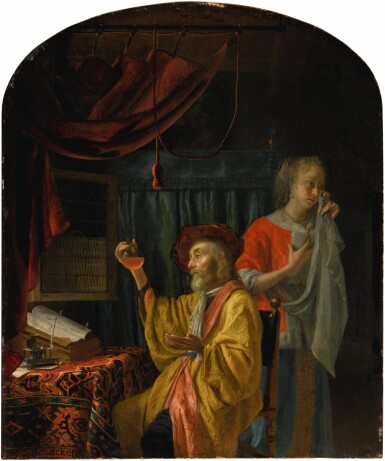
Property from a Private Collection | 私人收藏
GODFRIED SCHALCKEN | The Visit to the Doctor | 霍德弗里德・斯哈爾肯 | 《看病》
Auction Closed
December 4, 08:03 PM GMT
Estimate
100,000 - 150,000 GBP
Lot Details
Description
Property from a Private Collection
私人收藏
GODFRIED SCHALCKEN
霍德弗里德・斯哈爾肯
Made, near Breda 1643 - 1706 The Hague
1643年生於馬德(鄰近布雷達),1706年卒於海牙
The Visit to the Doctor
《看病》
signed and dated lower left: 1669 G. Schalcken
款識:藝術家簽名並紀年1669 G. Schalcken(左下)
oil on oak panel, arched top
油彩橡木畫板,拱形頂部
34 x 29 cm.; 13⅜ x 11⅜ in.
34 x 29公分;13 ⅜ x 11 ⅜英寸
Anonymous sale ('The Property of a Gentleman'), London, Christie's, 1 May 1964, lot 40, for 800 guineas to Knoedler;
Private collection, Belgium;
With Hans M. Kramer, The Hague, 1980 (catalogue XXII, no. 78);
Acquired for the present collection by 1984.
Philadelphia, Philadelphia Museum of Art, 18 March – 13 May 1984; Berlin-Dahlem, Gemäldegalerie, Staatliche Museen Preussischer Kulturbesitz, 8 June – 12 August 1984; London, Royal Academy of Arts, 7 September – 18 November 1984, Masters of Seventeenth Century Dutch Genre Painting, no. 98;
Cologne, Wallraf-Richartz-Museum, on loan, by 1986 until after 1993, inv. no. Dep. 530 (bears label on the reverse).
P. Thornton, Seventeenth-Century Interior Decoration in England, France and Holland, New Haven and London 1978, p. 136, reproduced fig. 109;
O. N[aumann], in P.C. Sutton (ed.), Masters of Seventeenth-Century Dutch Genre Painting, exh. cat., Philadelphia 1984, pp. 299–300, no. 98, reproduced plate 120;
Bestandkatalog, Cologne 1986, p. 77, inv. no. Dep. 530, reproduced fig. 403;
T. Beherman, Godfried Schalcken, Paris 1988, p. 253, no. 160, reproduced;
O. Ydema, Carpets and their Datings in Netherlandish Paintings 1540–1700, Leiden 1991, p. 144, no. 221;
C. S[tukenbrock], in E. Mai (ed.), Das Kabinett des Sammlers, exh. cat., Cologne 1993, pp. 228–30, no. 91, reproduced;
G. Jansen, in J. Turner (ed.), The Dictionary of Art, London 1996, vol. 28, p. 49;
A.K. Sevcik, Schalcken. Gemalte Verführung, exh. cat., Cologne 2015, pp. 128–29, under no. 16, reproduced fig. 16.2.
A young woman stands in tears in a scholarly interior, as an elderly man examines a flask of her urine, diagnosing her lovesickness, or perhaps her pregnancy, his left hand outstretched in a dramatic gesture of enlightenment. While we certainly sympathize with her plight in either case, this would have been seen as a comical painting in its own day, because the elderly man, presumably a doctor, is in fancy dress, and appears as a charlatan, so that his foolishness – that of old age and falsely assumed wisdom, and consequently of a quack – is contrasted with hers – that of innocent youth led astray. That this is a scene from a human comedy is underscored by the deliberately theatrical setting, with green curtains as a backdrop, and a red curtain hanging from a rod above the picture-plane partly drawn open to reveal the actors. Above and behind the bed a painting of the Virgin and Child hangs in the shadow.
In some comparable treatments of this subject in Dutch seventeenth-century painting, including others by Schalcken, the diagnosis of pregnancy is made specific. In a later work by Schalcken of circa 1680–85 for example, a miniature foetus appears in the flask of urine.1 In the present painting and in many others this is not so clearly the case. In a contemporary text by Jan van Beverwijck, the symptoms of lovesickness include a red and fiery urine, such as we see here.2 In any event the two diagnoses were not, and are not, mutually exclusive.
As his earliest dated work, this painting clearly shows that at the start of his documented career Gottfried Schalcken, already in his mid-30s was a Fijnschilder, and was exploring ideas and subjects developed by his second teacher, the Leiden painter Gerard Dou. Of several comparable works by Dou, his Doctor's Visit of 1653, also on an arched top panel, presents a good example.3 As the recent exhibition devoted to the subject showed, painters working in artistic centres such as Leiden, The Hague, Delft, Rotterdam and Dordrecht, as well as Haarlem and Amsterdam and further afield, were well aware of each others' work, and for the most part kept up to date with the latest trends in styles and subject matter in genre painting, in part because travel between these cities by regular and frequent horse-drawn ferry services was much easier and more reliable than used to be thought.4 Not only artists, but certainly agents, patrons and the art-buying public traveled these routes constantly, ensuring the spread of demand, for example for particular subjects, in particular love, its practice and its effects and results.
As Naumann observed, the same model that Schalcken used here for the Doctor occurs in two other undated but presumably also early works by him.5
When sold in 1964, the certificate of Dr C. Hofstede de Groot, dated 1917, was affixed to the reverse.
1 The Hague, Mauritshuis, inv. no. 161; see Sevcik 2015, pp. 129–30, no. 16, reproduced.
2 The other symptoms he described are a quick pulse, poor appetite, rapid mood changes, a pale complexion and sunken eyes; see J. van Beverwijck, Schat der Ongesontheyt, Dordrecht 1647, pp. 453–68. Pigment analysis shows that the urine in the flask was as orange as we see it now, and perhaps more so, since the inorganic yellow and the red lead pigments are stable, but the crimson glaze may have faded, which underscores the diagnosis as lovesickness.
3 Vienna, Kunsthistorisches Museum, inv. no. 592.
4 A.E. Waiboer, Vermeer and the Masters of Genre Painting, New Haven and London 2017 (the exhibition was held in Dublin, Washington and Paris).
5 One was sold, London, Christie's, 19 July 1973, lot 207 and the other is at the Städel, Frankfurt, inv. no. 166.
